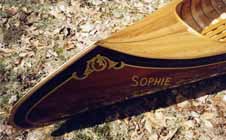Kevin Martin Wooden Boats & Canoes
Construction Techniques:
Wood & Canvas
Recognizing the value of the wood and canvas canoes after years of restoring them, I have decided to offer the Torpedo and the Courting Canoe built on original Kingsbury molds from the Boston area. These molds are for a sixteen and seventeen foot canoe. Both have classic curves with recurved stems, upswept gunwales, and great tumblehome. The flat bottom and full ends provide stability that is amazing for the beam while still offering great paddling for the experienced canoeist.
Wood and canvas canoes are designed to be flexible and give a little when beaching or encountering obstacles such as rocks or logs. The ribs are flat and wide and made of cedar. The canvas is not glued to the hull but is fastened under the gunwales and at the stems, producing a strong, yet giving hull.
 These canoes are built over a large form that has metal straps where the ribs are to go. Spruce inwales and ash stems are first steam bent and placed on this form. The ribs are of cedar 1/4" to 3/8" thick and 2 1/4" wide, and are tapered toward the gunwales. These are steamed around the form at the proper spacing over the metal straps and nailed to the spruce gunwales. Planking is 1/8 or 5/32" thick 2-3/4" to 3-3/4" wide cedar planks that are fastened by nailing them over the ribs with brass tacks and clinched as they hit the metal straps. Each plank is carefully selected and fit so the grain does not run off in areas where it could weaken the canoe.
These canoes are built over a large form that has metal straps where the ribs are to go. Spruce inwales and ash stems are first steam bent and placed on this form. The ribs are of cedar 1/4" to 3/8" thick and 2 1/4" wide, and are tapered toward the gunwales. These are steamed around the form at the proper spacing over the metal straps and nailed to the spruce gunwales. Planking is 1/8 or 5/32" thick 2-3/4" to 3-3/4" wide cedar planks that are fastened by nailing them over the ribs with brass tacks and clinched as they hit the metal straps. Each plank is carefully selected and fit so the grain does not run off in areas where it could weaken the canoe.
When the planking is complete, the hull is removed from the form, and the decks, thwarts and seats of ash or cherry are added. The canoe is then sanded and oiled and allowed to dry. Canvas is stretched around the outside of the hull and fastened with brass tacks. Two or three coats of an oil-based filler is applied to the canvas and allowed to dry for two or three weeks, this waterproofs the canoe. A keel is attached to the canoe at this point, and the hull is sanded and painted with several coats of colored enamel. The insides are oiled and varnished and brass stem bands are placed on the ends to protect the canvas. Outer gunwales finish off the trim and can be left open or closed with a cap rail. Options available include floorboards, outer stems, long decks, paint striping and lettering, backrests and sail rigs.


